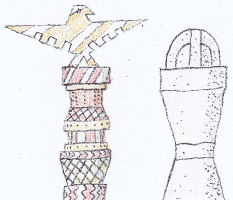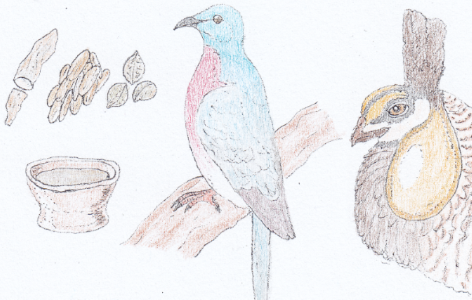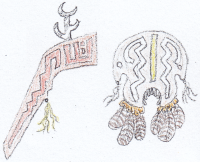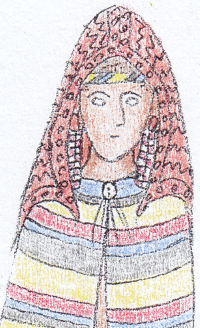Vevúni
The vevúni1 are the people inhabiting the eastern Gnákan Savanna and the northern Karatvánamb Forest of central and eastern Túlmikkía, respectively. They are divided into numerous different groups, from small, nomadic tribes to powerful kingdoms, all of whom speak related -though not always mutually intelligible- languages and have certain customs and religious practices in common.
Their territory borders the eastern Deþren Mountains to the northwest, Vagalkan to the north, Ænadó and the Talax Mountains to the northeast, the Tederans to the southeast, Kemmans to the south and southwest, and the Þárúlsans to the west.
Currently, the most powerful vevúni kingdoms are Gnúmá, Ókvatúlom and Tválara.
Earrings, necklaces, bracelets and anklets of all sorts are popular, as are face- and body-paint.
Many settlements, whether camps, villages or cities tend to follow a similar layout; homes encircle a common pasture for horses and eland antelopes, the ruler and other important individuals are clustered around a ceremonial plaza to the west, while the entrance to the settlement is always on the eastern side. The plaza usually features a pillar of some sort, around which the inhabitants perform a variety of rituals, mostly in the form of dances.
Red maize is grown to some extend by the northern tribes as well, and fishing is important to the ones living by the Túlmikkían Great Lakes and major rivers.
Soured eland antelope milk is the most common drink, along with a kind of beer made from bananas from the woodlands and, to lesser extend, galkan-style corn beer. Top-left: Yam, túlmikkían rice, peanuts. Left: Banana beer. Center: Passenger pigeon.
Right: Prairie chicken.
Every town and village has a ceremonial plaza with a pillar at its center, around which major ceremonies honouring this deity are performed; many vevúni believe that they were instructed to erect these pillars as they spread throughout the world, making frequent visits to his abode impractical at best.
While masks are used for certain rituals, they are generally not as ubiquitous as among the tederans.
Wooden clubs, both for throwing as well as close combat, are favoured by most vevúni, along with spears, bows and all sorts of throwing daggers, the latter which have multiple blades or hooks to inflict as grievous wounds as possible. The daggers and spearheads are made of iron, but iron armour and helmets are much rarer and mostly limited to gorgets and simple breastplates, as armour made of dyed shell- or wooden beads is widely believed to have supernatural properties.
Leather shields of various shapes and sizes are common, with a strip of cloth with beads sometimes attached to smaller shields to protect the legs against arrows and thrown daggers.
Their territory borders the eastern Deþren Mountains to the northwest, Vagalkan to the north, Ænadó and the Talax Mountains to the northeast, the Tederans to the southeast, Kemmans to the south and southwest, and the Þárúlsans to the west.
Currently, the most powerful vevúni kingdoms are Gnúmá, Ókvatúlom and Tválara.
Culture
Apparel
Vevúni clothing and hairstyles vary greatly from one tribe to another, and different warrior societies within each tribe have their own style as well. Clothes are generally made of hides or woven cloth, the latter are either made from local plant fibers or imported linen and wool, and are often adorned with fringes, porcupine quills, shells, soapstone- or wooden beads.Earrings, necklaces, bracelets and anklets of all sorts are popular, as are face- and body-paint.
Art
Architecture
The most common type of housing among the vevúni are longhouses, similar to those used by the tederans in southeastern Túlmikkía, made from a wooden frame with domed roof that's covered with such materials as bark, reed- or grass mats, heavy cloth, or clay. Stone is sometimes used for the homes of chiefs and kings, though its more commonly used for defensive walls, monuments and temples.Many settlements, whether camps, villages or cities tend to follow a similar layout; homes encircle a common pasture for horses and eland antelopes, the ruler and other important individuals are clustered around a ceremonial plaza to the west, while the entrance to the settlement is always on the eastern side. The plaza usually features a pillar of some sort, around which the inhabitants perform a variety of rituals, mostly in the form of dances.
Cuisine
Although it differs somewhat between different tribes and regions, most vevúni subsist on domesticated eland antelopes and prairie chickens along with such crops as túlmikkían rice (introduced by the tederans), yams and different varieties of peanuts, as well as wild game, notably passenger pigeons, pronghorns and various antelopes and large rodents.Red maize is grown to some extend by the northern tribes as well, and fishing is important to the ones living by the Túlmikkían Great Lakes and major rivers.
Soured eland antelope milk is the most common drink, along with a kind of beer made from bananas from the woodlands and, to lesser extend, galkan-style corn beer. Top-left: Yam, túlmikkían rice, peanuts. Left: Banana beer. Center: Passenger pigeon.
Right: Prairie chicken.
Religion
One notable feature in most vevúni myths is that there's little emphasis on the creation or eventual fate of the world, rather they focus on the origins of mankind, language, agriculture and animal husbandry, and various customs. Although certain animals and especially ancestral spirits are venerated, most vevúni are henotheists, that is their faith revolves mostly around a single -often distant and ill-defined- deity, often associated with the sky, certain mountains and lakes.Every town and village has a ceremonial plaza with a pillar at its center, around which major ceremonies honouring this deity are performed; many vevúni believe that they were instructed to erect these pillars as they spread throughout the world, making frequent visits to his abode impractical at best.
While masks are used for certain rituals, they are generally not as ubiquitous as among the tederans.
Warfare
Endemic warfare is the norm in most vevúni societies, whether against tederans, þárúlsans or amongst themselves, usually waged for control over land, resources or to avenge perceived slights against one another, though battles tend to be little more than skirmishes meant to show off and make the enemy rout rather than outright destroy them. However, those unfortunate enough to be captured inevitably face a long and painful death at the hand of the entire enemy tribe to avenge their fallen warriors.Wooden clubs, both for throwing as well as close combat, are favoured by most vevúni, along with spears, bows and all sorts of throwing daggers, the latter which have multiple blades or hooks to inflict as grievous wounds as possible. The daggers and spearheads are made of iron, but iron armour and helmets are much rarer and mostly limited to gorgets and simple breastplates, as armour made of dyed shell- or wooden beads is widely believed to have supernatural properties.
Leather shields of various shapes and sizes are common, with a strip of cloth with beads sometimes attached to smaller shields to protect the legs against arrows and thrown daggers.
1Original icelandic: Vevúnar, singular: Vevúni.
Related Locations








Comments